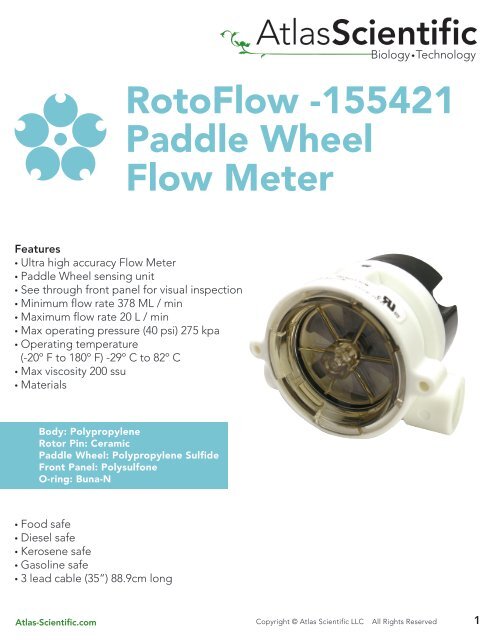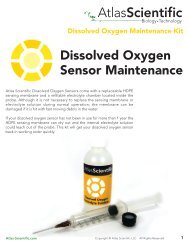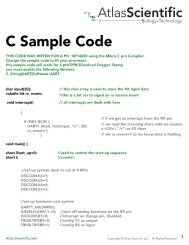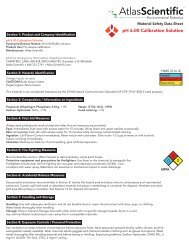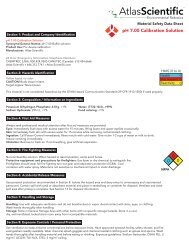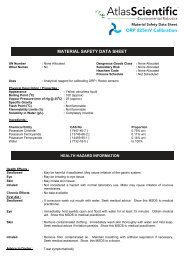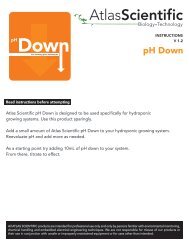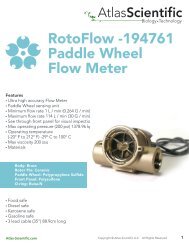RotoFlow -155421 Paddle Wheel Flow Meter - Atlas Scientific
RotoFlow -155421 Paddle Wheel Flow Meter - Atlas Scientific
RotoFlow -155421 Paddle Wheel Flow Meter - Atlas Scientific
Create successful ePaper yourself
Turn your PDF publications into a flip-book with our unique Google optimized e-Paper software.
<strong>Atlas</strong><strong>Scientific</strong><br />
Biology • Technology<br />
<strong>Roto<strong>Flow</strong></strong> -<strong>155421</strong><br />
<strong>Paddle</strong> <strong>Wheel</strong><br />
<strong>Flow</strong> <strong>Meter</strong><br />
Features<br />
• Ultra high accuracy <strong>Flow</strong> <strong>Meter</strong><br />
• <strong>Paddle</strong> <strong>Wheel</strong> sensing unit<br />
• See through front panel for visual inspection<br />
• Minimum flow rate 378 ML / min<br />
• Maximum flow rate 20 L / min<br />
• Max operating pressure (40 psi) 275 kpa<br />
• Operating temperature<br />
(-20º F to 180º F) -29º C to 82º C<br />
• Max viscosity 200 ssu<br />
• Materials<br />
Body: Polypropylene<br />
Rotor Pin: Ceramic<br />
<strong>Paddle</strong> <strong>Wheel</strong>: Polypropylene Sulfide<br />
Front Panel: Polysulfone<br />
O-ring: Buna-N<br />
• Food safe<br />
• Diesel safe<br />
• Kerosene safe<br />
• Gasoline safe<br />
• 3 lead cable (35”) 88.9cm long<br />
<strong>Atlas</strong>-<strong>Scientific</strong>.com<br />
Copyright © <strong>Atlas</strong> <strong>Scientific</strong> LLC All Rights Reserved<br />
1
Description<br />
The <strong>Roto<strong>Flow</strong></strong>-<strong>155421</strong> Paddel <strong>Wheel</strong> <strong>Flow</strong> <strong>Meter</strong> is an extremely accurate flow meter of<br />
moderate complexity. This flow meter requires specific timing and calculations to provide<br />
meaningful data. All of which is described in this datasheet.<br />
The <strong>Roto<strong>Flow</strong></strong>-<strong>155421</strong> provides the user with extremely reliable readings for flow rates from<br />
378 ml/min (0.1gpm) up to 75.7 L / min (20 gpm).<br />
Wiring<br />
The <strong>Roto<strong>Flow</strong></strong>-<strong>155421</strong> <strong>Flow</strong> <strong>Meter</strong> has an 71.1 (28”)<br />
cable that terminates with three tinned leads.<br />
PULSE<br />
<strong>Atlas</strong>-<strong>Scientific</strong>.com<br />
VCC<br />
GND<br />
Lead Color Function<br />
BLACK GND<br />
RED<br />
VCC 3V to 24V<br />
White PULSE<br />
<strong>Atlas</strong><strong>Scientific</strong><br />
Biology • Technology<br />
PULSE<br />
Microcontroller<br />
REVERSING THE POLARITY WILL<br />
DESTROY THE FLOW METER<br />
GND<br />
Copyright © <strong>Atlas</strong> <strong>Scientific</strong> LLC All Rights Reserved<br />
VCC<br />
2
Pre-filter Requirements<br />
<strong>Atlas</strong><strong>Scientific</strong><br />
Biology • Technology<br />
It is strongly recommended to use a pre-filter of at least 50 microns. <strong>Atlas</strong> <strong>Scientific</strong> has<br />
performed many tests on the <strong>Roto<strong>Flow</strong></strong>-<strong>155421</strong> <strong>Flow</strong> <strong>Meter</strong> and has concluded that<br />
reliable operation is not possible without one. The paddle wheel blades can easily<br />
become jammed with small particles that will (generally speaking) not damage the device,<br />
nor stop water flow; however the <strong>Roto<strong>Flow</strong></strong>-<strong>155421</strong> will no longer be accurate. To restore<br />
accuracy run water backwards through the <strong>Roto<strong>Flow</strong></strong>-<strong>155421</strong> until all the debris has been<br />
cleared.<br />
Data Output<br />
The White lead from the <strong>Roto<strong>Flow</strong></strong>-<strong>155421</strong> will output flow data in Hz from 0 to 200+ Hz.<br />
The <strong>Roto<strong>Flow</strong></strong>-<strong>155421</strong> <strong>Flow</strong> <strong>Meter</strong> does not simply convert pulses to volume. The pulse<br />
is only one part of the equation and cannot alone give meaningful flow data.<br />
EVENT EVENT<br />
<strong>Atlas</strong>-<strong>Scientific</strong>.com<br />
A pulse from the <strong>Roto<strong>Flow</strong></strong>-<strong>155421</strong><br />
is a rising edge, followed by a falling edge.<br />
Copyright © <strong>Atlas</strong> <strong>Scientific</strong> LLC All Rights Reserved<br />
3
<strong>Atlas</strong><strong>Scientific</strong><br />
Biology • Technology<br />
Best Practices for Data Interpretation<br />
using a Microcontroller<br />
The <strong>Roto<strong>Flow</strong></strong>-<strong>155421</strong> <strong>Flow</strong> <strong>Meter</strong> is relatively simple to interface with any microcontroller.<br />
Reading the frequency output from the <strong>Roto<strong>Flow</strong></strong>-<strong>155421</strong> should be done in one of two<br />
ways. [ISR method or Counter method]<br />
DO NOT POLL THE PIN DIRECTLY, THIS WILL RESULT IN INACCURACY<br />
ISR Method<br />
Connect the pulse out lead (white) to an external interrupt pin on your microcontroller.<br />
Set the interrupt pin to be triggered on a rising edge. Create an ISR (interrupt Service<br />
Routine) in your code that ONLY incurs a variable.<br />
ISR(void) {<br />
pulse_count +=1;<br />
}<br />
Use a section in your main code to poll the variable pulse_count and<br />
to do the necessary math<br />
main(void){<br />
while(1){<br />
if (pulse_count){<br />
total_flow+=pulse_count;<br />
pulse_count=0;<br />
}<br />
}<br />
Counter Method<br />
Enable the timer/counter on your microcontroller, and set it to counter mode. It is<br />
advised that you use a 16 bit or larger counter. The counter will have an internal registry<br />
variable that will count the pulses. How you then read and interpret that registry value is<br />
for you to decide.<br />
<strong>Atlas</strong>-<strong>Scientific</strong>.com<br />
Copyright © <strong>Atlas</strong> <strong>Scientific</strong> LLC All Rights Reserved<br />
4
Data Interpretation<br />
To turn the pulses into flow rate you must obtain the pulses per minute. It is imperative<br />
that your microcontroller has a reliable clock source that is capable of interrupting every<br />
one second. Using R.T.C. is not advised, unless the R.T.C. can interrupt your<br />
microcontroller every one second.<br />
A better option is to simply connect a 32.768 KHz crystal to the timer/counter of your<br />
microcontroller and use that to interupt every one second.<br />
Count the pulses that your microcontroller receives each second. After 15 seconds add<br />
up all the pulses received and multiply that by four.<br />
Example<br />
After 15 seconds the microcontroller has detected 25 pulses.<br />
25 x 4 = 100<br />
This is a simple way of deriving pulses per minuet without having to wait a whole minute<br />
before knowing the time pulses per minuet.<br />
(15 seconds x 4 = 60 seconds)<br />
Assuming that we stored the number of pulses in the variable “pulses_per_min” the<br />
following code shows how to derive pluses per minute to volume and volume per<br />
minute.<br />
pulses_per_min * = 4; //multipliying the pluses times four<br />
volume=0.6662338572e-2 + 0.1666328970e-2 * pulses_per_min;<br />
flow_rate=(volume*60);<br />
<strong>Atlas</strong>-<strong>Scientific</strong>.com<br />
<strong>Atlas</strong><strong>Scientific</strong><br />
Biology • Technology<br />
<strong>Atlas</strong> <strong>Scientific</strong> has determined these equations to be accurate<br />
in reading volume and flow rate for the <strong>Roto<strong>Flow</strong></strong>-<strong>155421</strong>.<br />
Copyright © <strong>Atlas</strong> <strong>Scientific</strong> LLC All Rights Reserved<br />
5


